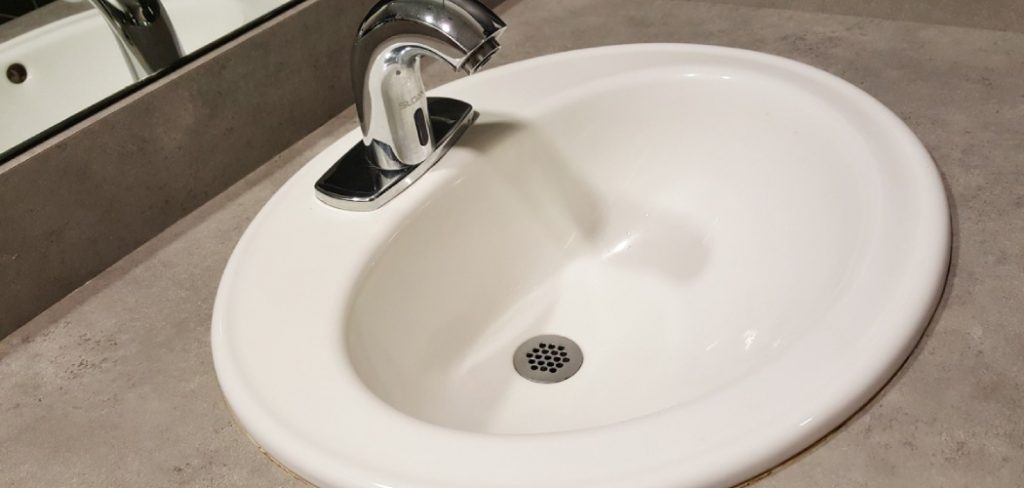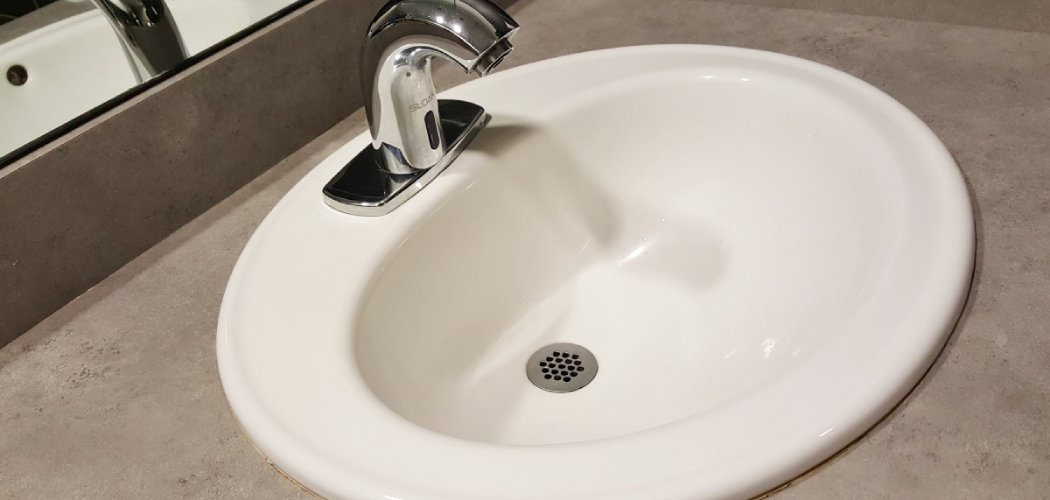Are you tired of staring at your dingy and discolored porcelain sink every day? Perhaps it’s time for a change! Before you call in a professional to replace it, why not try painting it instead? Painting your sink is a budget-friendly way to give your bathroom a fresh new look without breaking the bank. In this blog post, we’ll guide you through every step of how to paint porcelain sink for a successful makeover.

Can You Paint the Porcelain Sink?
Are you tired of looking at that old, stained porcelain sink in your bathroom or kitchen? It may be tempting to replace it altogether, but why not consider sprucing it up with a fresh coat of paint instead? Yes, you read that right- you can paint porcelain sinks! With the right materials and some time, you can transform your dingy old sink into a sleek, modern fixture.
Just think, no more awkwardly hiding the sink with cleaning supplies when guests come over. Now it will be a show-stopping piece in your home. So why not give it a try? It may just be the cost-effective solution you’ve been searching for.
Why Should You Paint Porcelain Sink?
A porcelain sink is an elegant addition to any bathroom, kitchen, or laundry room. As time goes on, however, the porcelain finish can become dull, chipped, or discolored. Painting your porcelain sink may seem daunting, but it can give your bathroom or kitchen a fresh look.
Not only does it require less time and expense than replacing the sink entirely, but it also allows you to customize your sink’s look to match your style. With various paints and techniques available for porcelain sinks, this DIY project can be a creative and rewarding endeavor for any home improvement enthusiast.

Everything You Need to Know on How to Paint Porcelain Sink
Step 1: Preparation
Before you start painting your sink, you’ll need to prepare it properly. Clean the sink with soap and water, then dry it thoroughly. Use fine-grit sandpaper to rough up the sink’s surface, which will help the paint adhere to it. Next, wipe the sink down with alcohol to remove any remaining dirt or residue.
Step 2: Masking
You’ll need to mask off the surrounding areas of the sink that you don’t want to be painted. Use painter’s tape to cover up the edges of the sink and the fixtures. Place plastic or drop cloths over the sink and surrounding surfaces to protect them from paint splatters.
Step 3: Priming
Before you apply the paint, you’ll need to apply a coat of primer. Primer helps the paint stick to the surface and provides a smooth, even base for the paint. Use a high-quality primer that’s specially formulated for porcelain surfaces. Apply the primer using a foam roller or brush and allow it to dry for at least 24 hours.
Step 4: Painting
Now it’s time to paint your sink! Use a paint that’s designed specifically for porcelain surfaces. You can choose from various colors, so pick one that complements your bathroom decor. Apply the paint using a foam roller or brush, being careful not to apply it too thickly. Allow the paint to dry completely before applying a second coat if needed.
Step 5: Curing
After your paint has dried, it’s important to cure it properly. This will ensure the paint adheres to the surface and won’t chip or peel off over time. You’ll need to let the painted sink sit untouched for at least seven days before you use it. This gives the paint enough time to bond with the porcelain.
Step 6: Finishing Touches
Once your sink has finished curing, you can install it in your bathroom. Use a screwdriver to attach the fixtures and faucets to the sink. Finally, add some decorative accents, such as new cabinet hardware or a mirror frame, for an updated look.

Step 7: Maintenance
To keep your painted sink looking its best, it’s important to clean and maintain it properly. Wipe the surface with a soft cloth dampened with warm water and mild soap or detergent. Avoid harsh chemicals or abrasive scrubbers, as these can damage the paint.
You should also avoid letting standing water sit on the sink for long periods. Use a squeegee to remove any excess water or a towel to dry the surface after each use. With regular maintenance, your painted porcelain sink will look beautiful for years.
5 Considerations Things When You Need to Paint Porcelain Sink
1. Clean the Sink
Before you paint your porcelain sink, it is important to ensure it is properly cleaned. Use a mild detergent and warm water to remove dirt or debris from the sink’s surface. Once the sink has been thoroughly cleaned, use a damp cloth to remove any residue. Allow the sink to dry completely before beginning the painting process.
2. Sand the Surface
Once the sink is clean and dry, it is important to sand down any rough spots on the surface of the porcelain. Use fine-grit sandpaper and gently sand until all rough patches are removed. Ensure you wear protective gloves and eye protection when sanding your porcelain sink.
3. Prime the Sink
After sanding, it is important to prime your porcelain sink before applying paint. Primer helps to create a smooth surface for painting and will also help ensure that your paint adheres properly to the surface of your sink. Use a brush or roller to apply a primer in even strokes across the entire surface of your porcelain sink. Allow the primer to dry completely before continuing with painting.

4. Choose Your Paint
When selecting paint for your porcelain sink, make sure that you choose one that is specifically designed for use on ceramic surfaces such as sinks and bathtubs. This type of paint will be more durable than regular latex or oil-based paints and will also help ensure that your painted finish lasts longer without chipping or peeling off over time.
5. Paint in Even Strokes
Once you have selected your paint, apply a thin layer across the entire surface of your porcelain sink using even strokes with a brush or roller. Allow each coat of paint to dry completely before adding additional coats if needed for better coverage or color saturation. Once you have achieved your desired result, allow the paint to fully cure before using your newly painted porcelain sink!
5 Benefits of Paint Porcelain Sink
1. Durability
Porcelain sinks are incredibly durable and can last many years without needing replacement. Porcelain is a hard, non-porous material resistant to scratches, chips, and stains. It also does not absorb odors or bacteria, making it ideal for kitchen and bathroom sinks. Additionally, porcelain sinks require little maintenance and can easily be cleaned with soap and water.
2. Variety of Colors
Porcelain sinks come in various colors, so you can easily find one that matches your decor. The wide range of colors makes it easy to find a sink that complements any kitchen or bathroom design scheme. From classic whites and creams to bold blues and greens, there will surely be a color that fits your needs.
3. Easy Installation
Another benefit of porcelain sinks is that they are relatively easy to install compared to other materials such as stainless steel or granite. All you need is some basic tools and the instructions included with the sink to install it properly. This makes them an ideal choice for do-it-yourselfers who want to upgrade their kitchen or bathroom without spending too much on installation costs.
4. Affordable Price
Porcelain sinks are also quite affordable compared to other materials, such as stainless steel or granite, which tend to be more expensive when upgrading your kitchen or bathroom sink area. You can usually find good quality porcelain sinks at reasonable prices from most home improvement stores or online retailers, making them an attractive option for those looking for an affordable way to upgrade their space without breaking the bank.

5. Versatility
Finally, porcelain sinks offer a lot of versatility when it comes to design options as they come in a variety of shapes and sizes, so you can easily find one that fits your specific needs whether you’re looking for something small enough for a half bath or large enough for a full kitchen remodel project.
Additionally, most porcelain sinks have pre-drilled holes, so you can easily add faucets and accessories without having to drill additional holes into the countertop surface, making them perfect for those looking for an easy way to update their space quickly and affordably.
6 Common Mistakes People Make When Trying to Paint Porcelain Sink
1. Not Using the Right Paint
One of the most common mistakes people make when painting a porcelain sink is not using the right paint. Porcelain sinks require a special type of paint designed for porcelain surfaces. This type of paint will adhere better to the surface and provide a long-lasting finish. Additionally, it is important to choose a paint rated for high-humidity environments, as bathrooms are often damp and humid.
2. Not Cleaning the Sink Properly
Another mistake people make when painting their porcelain sink is not cleaning it properly before they begin. It is important to thoroughly clean and dry the sink before starting any painting project, as dirt and debris can interfere with the adhesion of the paint and cause it to peel off over time. Additionally, it is important to remove any rust or corrosion from the surface before applying any paint.

3. Not Sanding Before Painting
Another mistake people often make when painting their porcelain sink is not sanding beforehand. Sanding helps create an even surface by removing any imperfections or bumps on the sink’s surface.
This will ensure that your final coat of paint has an even finish without any lumps or bumps in it. It is also important to use fine-grit sandpaper so as not to damage the surface of your sink while sanding it down.
4. Not Applying Primer
Applying primer before painting your porcelain sink is also essential for achieving a smooth, even finish with your final coat of paint. Primer helps prepare your surface by filling in any cracks or crevices and creating an even base for your paint job.
Additionally, primer helps improve adhesion between your sink and its new coat of paint, which will help ensure that your newly painted sink lasts longer without chipping or peeling off over time.
5. Not Allowing Adequate Drying Time
Giving each layer enough time to dry properly before moving on to another one is also key for achieving good results when painting a porcelain sink. Each layer should be given at least 24 hours to dry completely before adding another layer on top of it; this will ensure that all layers bond together properly and don’t chip away over time due to moisture trapped underneath them from inadequate drying times between coats.
6. Not Applying Enough Coats
Finally, many people make the mistake of not applying enough coats when they are painting their porcelain sinks; this can lead to poor results in terms of both durability and appearance since fewer coats mean less protection against wear and tear over time, as well as less vibrant colors in terms of overall look, once finished with all coats applied. To achieve the best results, it is important to apply at least three coats of paint for optimal coverage and protection.

By following these steps and avoiding these common mistakes when painting your porcelain sink, you can ensure that your project will have professional-looking results lasting for years! With the right preparation, tools, and materials, anyone can paint a beautiful porcelain sink that looks like a professional did it. So don’t be intimidated; follow these steps, and you’ll surely have a beautiful, long-lasting paint job that you will enjoy for years.
Conclusion
Painting your porcelain sink is a simple and cost-effective way to give your bathroom a new lease of life. By following these steps, you can achieve a professional-looking finish that will last for years to come.
Whether you’re upgrading your sink for yourself or planning to sell your home, a freshly painted porcelain sink will help you achieve your goals. So why not give it a try? Transform your bathroom and create a space you can enjoy for years. Thanks for reading our post about how to paint porcelain sink.

